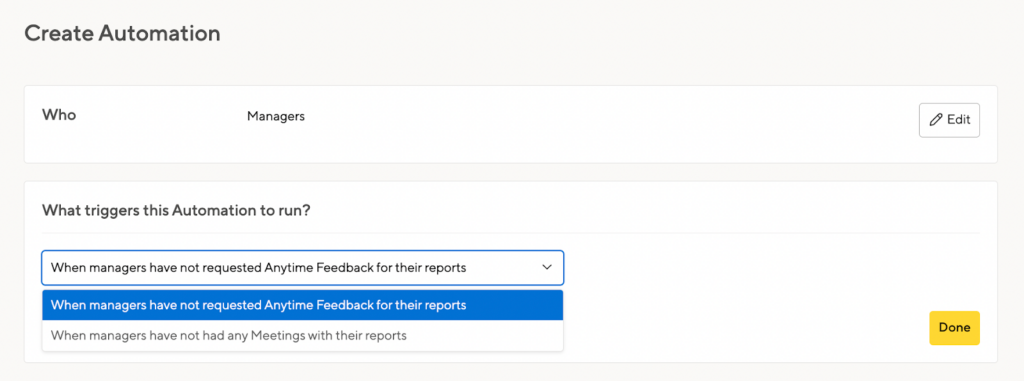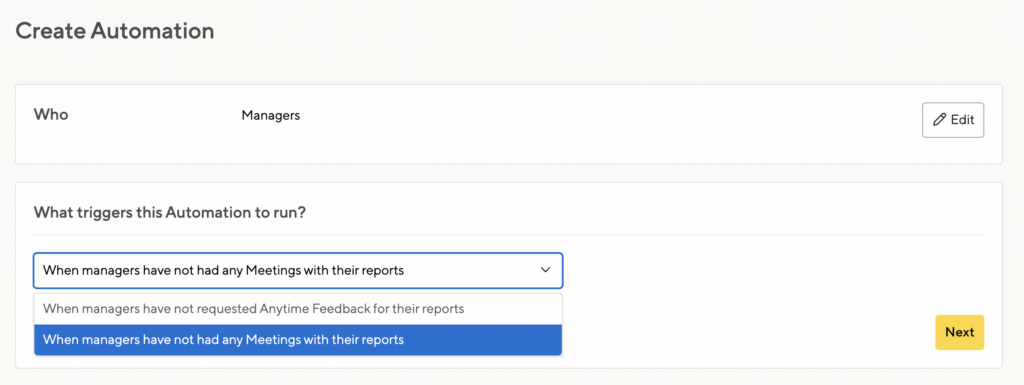Automations is our newest feature in Beta and offers two main functionalities for HR Admins. Understanding the two will help you choose which Automation to employ and use effectively:
- Automated Feedback Requests: These requests can be used as a check-in for a new hire based on their hire date or just to touch base with your employees on a regular basis.
- Automated Reminders: These automations are triggered by specific events. They are then sent to the chosen group via Slack or email (set by you).
Automated Reminders
With Automated Reminders, HR Admins and managers will be able to streamline processes, cut down repetitive and manual work, and nudge positive behaviors within the organization.
In this recipe, we’ll explore some of the benefits of using Automated Reminders, examples of how and for what purposes it can be used, and some key considerations to keep in mind.
For a more step-by-step guide on how to set it up, please have a look at the Help Center article for Automated Reminders.
The first thing to note is that the Reminder process changes depending on who the reminder is for: All employees or managers
Automated Reminders for managers

There are two triggers to choose from when setting up Automated Reminders for managers:
- When managers have not requested Anytime Feedback for their reports
- When managers have not had any meetings with their reports
When managers have not requested Anytime Feedback for their reports

Requesting feedback will help managers become better. By asking their team how they have been doing and how they can be better supported, they can learn a lot about what is expected of them and how they can be a better manager.
There are understandable anxieties around requesting feedback although the benefits are well-known. That is why managers need to endorse participation in and normalize requesting feedback, as this will influence how employees perceive Anytime Feedback. After all, if the managers at an org aren’t asking for feedback, why should the employees?
With time, practice, and habit, we tend to see fears around requesting feedback fade as it becomes a normal part of work.
When managers have not had any meetings with their reports

Managers are essential drivers in developing a thriving feedback culture in the org. Regularly aligning with their direct reports over regular meetings will help guide team members’ development, resolve issues early on, and improve employee retention.
Managers need to practice and role-model having regular 1:1s with their reports. But instilling the habit can be challenging if regularly checking-in with employees is not the norm. Coupled with the daily stresses of a busy workday, making time for regular meetings can naturally fall to the sidelines.
This is where an Automated Reminder comes in handy.
You can set up an Automated Reminder for managers who have not had a meeting with their reports. The time in which they haven’t had a meeting is up to you. We recommend a range of 2 to 6 weeks as a trigger. Let’s say you’ve set up the condition as managers not having had a meeting in 6 weeks. That means if a manager goes 6 weeks without meeting, they will receive an Automated Reminder.
Automated Reminders for employees

In addition to Reminders for managers, you can send Automated Reminders for all employees. This type of Reminder is more free-form and allows you more flexibility with the content Here are some examples of Reminders you can automate:
Encourage Praise in the organization
People like to be recognized. It’s been proven to be an effective motivator and can work wonders for employee well-being and happiness.
Increase the requesting and giving of feedback all throughout the org
Although managers play an important role, requesting and giving feedback among all employees drives the same benefits for ICs as it does for managers.
Nudge employees to update their Objectives
Remind employees to continuously track their progress on their Objectives to help them stay accountable to their project and personal goals.
Benefits for HR Admins
What does this mean for you? Well, it means you’ll eliminate the task of tracking and following-up on managers. You’ll also be nurturing a habit of regular meetings at your organization, which has proven effects on engagement, retention, and productivity.
Giving and receiving feedback is not a habit that forms overnight. While our platform enables feedback, it takes a shift within the organization to promote engagement with the features. With regular reminders, you can start to promote a company culture around feedback.
Key considerations
Make sure user data is up-to-date
Before creating automations, ensure that user data is up to date. Accurate and updated data, including hiring dates, department information, and locations, is essential for optimal automation performance. Examples of important updates include correct role titles, departments, managers, and locations. This means that the Reminders you set are delivered to the right people.
We provide streamlined directory export. The directory export feature supports direct re-importing with the same formatting, such as through the CSV importer or integrations, to make it easier for you to update your data efficiently.
Avoid spamming people
While reminders are essential for instilling habits, it’s important to strike a balance. Try not to overwhelm users with excessive notifications.
Exclude specific employees
You caninclude or exclude specific employees when setting up Automated Reminders. For example, you may not want to send reminders to a senior executive like the CEO. Alternatively, you may only want to send reminders to the team leads of specific project groups.
Timebox end dates
When sending organization-wide reminders, include an end date to ensure timely follow-ups and prevent indefinite reminders.
Strategic timing
Consider how Automations align with other ongoing cycles or initiatives, such as Performance Review or 360 Feedback Cycles. We suggest maintaining a calendar view to avoid conflicts.